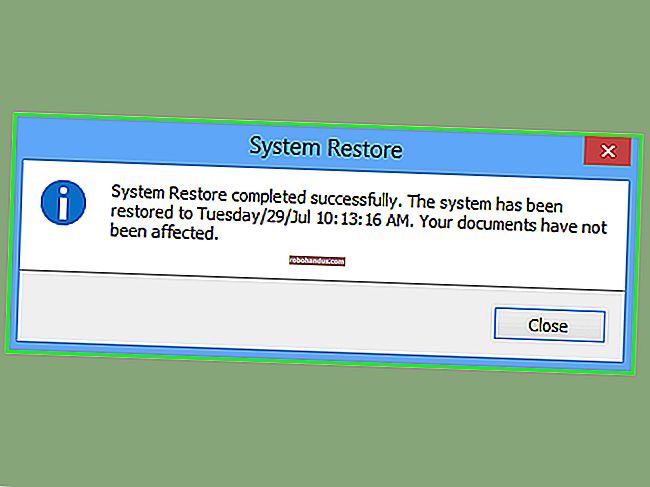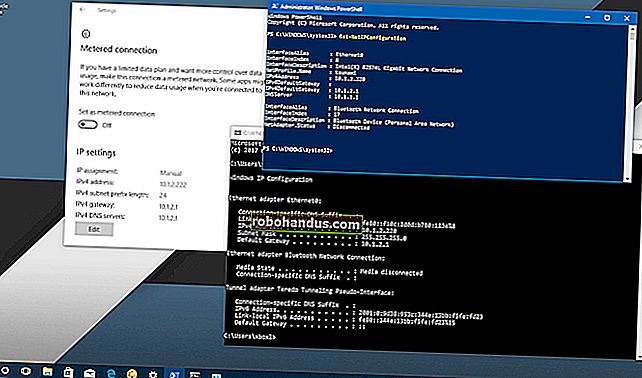Cara Bekerja dengan Variabel di Bash

Variabel sangat penting jika Anda ingin menulis skrip dan memahami apa yang akan dilakukan kode yang akan Anda potong dan tempel dari web ke komputer Linux Anda. Kami akan membantu Anda memulai!
Variabel 101
Variabel diberi nama simbol yang mewakili string atau nilai numerik. Saat Anda menggunakannya dalam perintah dan ekspresi, mereka diperlakukan seolah-olah Anda mengetikkan nilai yang mereka pegang alih-alih nama variabel.
Untuk membuat variabel, Anda cukup memberikan nama dan nilainya. Nama variabel Anda harus deskriptif dan mengingatkan Anda akan nilainya. Nama variabel tidak boleh dimulai dengan angka, juga tidak boleh berisi spasi. Namun, ini bisa dimulai dengan garis bawah. Selain itu, Anda dapat menggunakan campuran karakter alfanumerik huruf besar dan kecil.
Contoh
Di sini, kami akan membuat lima variabel. Formatnya adalah mengetik nama, tanda sama dengan =, dan nilainya. Perhatikan bahwa tidak ada spasi sebelum atau sesudah tanda sama dengan. Memberi variabel nilai sering disebut sebagai memberikan nilai ke variabel.
Kami akan membuat empat variabel string dan satu variabel numerik, this_year:
saya = Dave
my_boost = Linux
dia = Popeye
his_boost = Bayam
this_year = 2019

Untuk melihat nilai yang disimpan dalam variabel, gunakan echoperintah. Anda harus mengawali nama variabel dengan tanda dolar $setiap kali Anda mereferensikan nilai yang dikandungnya, seperti yang ditunjukkan di bawah ini:
echo $ my_name
echo $ my_boost
echo $ this_year

Mari gunakan semua variabel kita sekaligus:
echo "$ my_boost adalah $ saya karena $ his_boost menjadi $ him (c) $ this_year"

Nilai variabel menggantikan namanya. Anda juga dapat mengubah nilai variabel. Untuk menetapkan nilai baru ke variabel, my_boostAnda cukup mengulangi apa yang Anda lakukan saat menetapkan nilai pertamanya, seperti ini:
my_boost = Tequila

Jika Anda menjalankan kembali perintah sebelumnya, Anda sekarang mendapatkan hasil yang berbeda:
echo "$ my_boost adalah $ saya karena $ his_boost menjadi $ him (c) $ this_year"

Jadi, Anda dapat menggunakan perintah yang sama yang mereferensikan variabel yang sama dan mendapatkan hasil berbeda jika Anda mengubah nilai yang disimpan dalam variabel.
Kami akan berbicara tentang mengutip variabel nanti. Untuk saat ini, berikut beberapa hal yang perlu diingat:
- Variabel dalam tanda kutip tunggal
'diperlakukan sebagai string literal, dan bukan sebagai variabel. - Variabel dalam tanda kutip
"diperlakukan sebagai variabel. - Untuk mendapatkan nilai yang disimpan dalam variabel, Anda harus memberikan tanda dolar
$. - Variabel tanpa tanda dolar
$hanya memberikan nama variabel.

Anda juga dapat membuat variabel yang mengambil nilainya dari variabel atau jumlah variabel yang ada. Perintah berikut mendefinisikan variabel baru yang dipanggil drink_of_the_Year,dan memberinya nilai gabungan dari variabel my_boostdan this_year:
drink_of-the_Year = "$ my_boost $ this_year"
echo drink_of_the-Year

Cara Menggunakan Variabel dalam Skrip
Skrip akan sepenuhnya rusak tanpa variabel. Variabel memberikan fleksibilitas yang membuat skrip menjadi solusi umum, bukan spesifik. Untuk mengilustrasikan perbedaannya, berikut ini skrip yang menghitung file dalam /devdirektori.
Ketik ini ke dalam file teks, lalu simpan sebagai fcnt.sh(untuk "jumlah file"):
#! / bin / bash folder_to_count = / dev file_count = $ (ls $ folder_to_count | wc -l) echo $ file_count file di $ folder_to_count
Sebelum Anda dapat menjalankan skrip, Anda harus membuatnya dapat dieksekusi, seperti yang ditunjukkan di bawah ini:
chmod + x fcnt.sh

Ketik berikut ini untuk menjalankan skrip:
./fcnt.sh

Ini mencetak jumlah file di /devdirektori. Begini cara kerjanya:
- Variabel yang dipanggil
folder_to_countdidefinisikan, dan itu disetel untuk menampung string "/ dev." - Another variable, called
file_count, is defined. This variable takes its value from a command substitution. This is the command phrase between the parentheses$( ). Note there’s a dollar sign$before the first parenthesis. This construct$( )evaluates the commands within the parentheses, and then returns their final value. In this example, that value is assigned to thefile_countvariable. As far as thefile_countvariable is concerned, it’s passed a value to hold; it isn’t concerned with how the value was obtained. - The command evaluated in the command substitution performs an
lsfile listing on the directory in thefolder_to_countvariable, which has been set to “/dev.” So, the script executes the command “ls /dev.” - The output from this command is piped into the
wccommand. The-l(line count) option causeswcto count the number of lines in the output from thelscommand. As each file is listed on a separate line, this is the count of files and subdirectories in the “/dev” directory. This value is assigned to thefile_countvariable. - The final line uses echo to output the result.
But this only works for the “/dev” directory. How can we make the script work with any directory? All it takes is one small change.
How to Use Command Line Parameters in Scripts
Many commands, such as ls and wc, take command line parameters. These provide information to the command, so it knows what you want it to do. If you want ls to work on your home directory and also to show hidden files, you can use the following command, where the tilde ~ and the -a (all) option are command line parameters:
ls ~ -a
Our scripts can accept command line parameters. They’re referenced as $1 for the first parameter, $2 as the second, and so on, up to $9 for the ninth parameter. (Actually, there’s a $0, as well, but that’s reserved to always hold the script.)
You can reference command line parameters in a script just as you would regular variables. Let’s modify our script, as shown below, and save it with the new name fcnt2.sh:
#!/bin/bash folder_to_count=$1 file_count=$(ls $folder_to_count | wc -l) echo $file_count files in $folder_to_count
This time, the folder_to_count variable is assigned the value of the first command line parameter, $1.
The rest of the script works exactly as it did before. Rather than a specific solution, your script is now a general one. You can use it on any directory because it’s not hardcoded to work only with “/dev.”
Here’s how you make the script executable:
chmod +x fcnt2.sh

Now, try it with a few directories. You can do “/dev” first to make sure you get the same result as before. Type the following:
./fnct2.sh /dev
./fnct2.sh /etc
./fnct2.sh /bin

You get the same result (207 files) as before for the “/dev” directory. This is encouraging, and you get directory-specific results for each of the other command line parameters.
To shorten the script, you could dispense with the variable, folder_to_count, altogether, and just reference $1 throughout, as follows:
#!/bin/bash file_count=$(ls $1 wc -l) echo $file_count files in $1
Working with Special Variables
We mentioned $0, which is always set to the filename of the script. This allows you to use the script to do things like print its name out correctly, even if it’s renamed. This is useful in logging situations, in which you want to know the name of the process that added an entry.
The following are the other special preset variables:
- $#: How many command line parameters were passed to the script.
- $@: All the command line parameters passed to the script.
- $?: The exit status of the last process to run.
- $$: The Process ID (PID) of the current script.
- $USER: The username of the user executing the script.
- $HOSTNAME: The hostname of the computer running the script.
- $SECONDS: The number of seconds the script has been running for.
- $RANDOM: Returns a random number.
- $LINENO: Returns the current line number of the script.
You want to see all of them in one script, don’t you? You can! Save the following as a text file called, special.sh:
#!/bin/bash echo "There were $# command line parameters" echo "They are: $@" echo "Parameter 1 is: $1" echo "The script is called: $0" # any old process so that we can report on the exit status pwd echo "pwd returned $?" echo "This script has Process ID $$" echo "The script was started by $USER" echo "It is running on $HOSTNAME" sleep 3 echo "It has been running for $SECONDS seconds" echo "Random number: $RANDOM" echo "This is line number $LINENO of the script"
Type the following to make it executable:
chmod +x special.sh

Now, you can run it with a bunch of different command line parameters, as shown below.

Environment Variables
Bash uses environment variables to define and record the properties of the environment it creates when it launches. These hold information Bash can readily access, such as your username, locale, the number of commands your history file can hold, your default editor, and lots more.
To see the active environment variables in your Bash session, use this command:
env | less

If you scroll through the list, you might find some that would be useful to reference in your scripts.

How to Export Variables
When a script runs, it’s in its own process, and the variables it uses cannot be seen outside of that process. If you want to share a variable with another script that your script launches, you have to export that variable. We’ll show you how to this with two scripts.
First, save the following with the filename script_one.sh:
#!/bin/bash first_var=alpha second_var=bravo # check their values echo "$0: first_var=$first_var, second_var=$second_var" export first_var export second_var ./script_two.sh # check their values again echo "$0: first_var=$first_var, second_var=$second_var"
This creates two variables, first_var and second_var, and it assigns some values. It prints these to the terminal window, exports the variables, and calls script_two.sh. When script_two.sh terminates, and process flow returns to this script, it again prints the variables to the terminal window. Then, you can see if they changed.
The second script we’ll use is script_two.sh. This is the script that script_one.shcalls. Type the following:
#!/bin/bash # check their values echo "$0: first_var=$first_var, second_var=$second_var" # set new values first_var=charlie second_var=delta # check their values again echo "$0: first_var=$first_var, second_var=$second_var"
This second script prints the values of the two variables, assigns new values to them, and then prints them again.
To run these scripts, you have to type the following to make them executable:
chmod +x script_one.sh chmod +x script_two.sh

And now, type the following to launch script_one.sh:
./script_one.sh

This is what the output tells us:
- script_one.sh prints the values of the variables, which are alpha and bravo.
- script_two.sh prints the values of the variables (alpha and bravo) as it received them.
- script_two.sh changes them to charlie and delta.
- script_one.sh prints the values of the variables, which are still alpha and bravo.
What happens in the second script, stays in the second script. It’s like copies of the variables are sent to the second script, but they’re discarded when that script exits. The original variables in the first script aren’t altered by anything that happens to the copies of them in the second.
How to Quote Variables
You might have noticed that when scripts reference variables, they’re in quotation marks ". This allows variables to be referenced correctly, so their values are used when the line is executed in the script.
If the value you assign to a variable includes spaces, they must be in quotation marks when you assign them to the variable. This is because, by default, Bash uses a space as a delimiter.
Here’s an example:
site_name=How-To Geek

Bash sees the space before “Geek” as an indication that a new command is starting. It reports that there is no such command, and abandons the line. echo shows us that the site_name variable holds nothing—not even the “How-To” text.
Try that again with quotation marks around the value, as shown below:
site_name="How-To Geek"

This time, it’s recognized as a single value and assigned correctly to the site_name variable.
echo Is Your Friend
It can take some time to get used to command substitution, quoting variables, and remembering when to include the dollar sign.
Before you hit Enter and execute a line of Bash commands, try it with echo in front of it. This way, you can make sure what’s going to happen is what you want. You can also catch any mistakes you might have made in the syntax.






